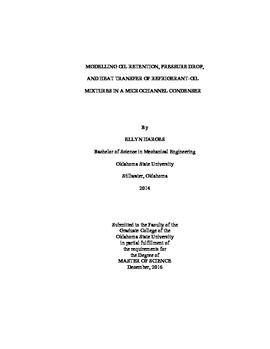| dc.contributor.advisor | Cremaschi, Lorenzo | |
| dc.contributor.author | Harges, Ellyn | |
| dc.date.accessioned | 2018-06-29T14:40:59Z | |
| dc.date.available | 2018-06-29T14:40:59Z | |
| dc.date.issued | 2016-12-01 | |
| dc.identifier.uri | https://hdl.handle.net/11244/300347 | |
| dc.description.abstract | Microchannel heat exchangers have improved heat transfer capabilities as well as reduced charge when compared to conventional fin and tube heat exchangers. These characteristics led to their increasing application in residential heating and air conditioning systems. Models that can quickly and accurately predict their behavior are necessary for system design and optimization purposes. This research presents a discretized microchannel heat exchanger model which extends beyond pure heat transfer modelling to include pressure drop, charge, and oil retention modelling.This project takes an already existing microchannel condenser model, evaluates its strengths and weaknesses using experimental data, improves it, and uses it to investigate modelling of oil retention in microchannel condensers. It was found that the oil retention model presented in this thesis underpredicts experimental oil retention data from Yatim et al. (2016). The oil retention model only takes into account oil that is carried through the condenser with the refrigerant, so it was determined that there must also be oil trapped somewhere in the condenser. It was also determined that this trapped oil cannot solely reside as a film on the inside of the microchannel tubes; if this were the case, pressure drop would greatly increase, an occurrence which was not observed in the experiments or the simulation results. Since a significant amount of oil cannot reside in the microchannel tubes, the most likely place for the oil to be is in the inlet header. The refrigerant in this component is always superheated, and so cannot carry the oil through the condenser as well as if it were part liquid. Based on analyses performed in this research, the assumption that the trapped oil all resides in the inlet header is good for some flow conditions, but not all. Future work in oil retention modelling should focus on how mass flux, saturation temperature, refrigerant-oil miscibility, and degree of superheat affect the oil that is trapped in the condenser. | |
| dc.format | application/pdf | |
| dc.language | en_US | |
| dc.rights | Copyright is held by the author who has granted the Oklahoma State University Library the non-exclusive right to share this material in its institutional repository. Contact Digital Library Services at lib-dls@okstate.edu or 405-744-9161 for the permission policy on the use, reproduction or distribution of this material. | |
| dc.title | Modelling Oil Retention, Pressure Drop, and Heat Transfer of Refrigerant-oil Mixtures in a Microchannel Condenser | |
| dc.contributor.committeeMember | Fisher, Daniel | |
| dc.contributor.committeeMember | Bach, Christian | |
| osu.filename | Harges_okstate_0664M_14987.pdf | |
| osu.accesstype | Open Access | |
| dc.description.department | Mechanical & Aerospace Engineering | |
| dc.type.genre | Thesis | |
| dc.type.material | text | |
